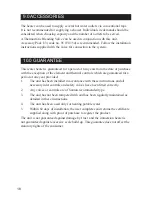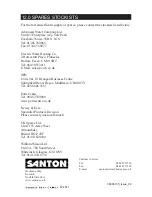
8
G3 GUIDANCE SECTION 3.9
The discharge pipe (D2) from the tundish should terminate in a safe place where
there is no risk to persons in the vicinity of the discharge, preferably be of metal
and:
1 Be at least one pipe size larger than the nominal outlet size of the safety device
unless its total equivalent hydraulic resistance exceeds that of a straight pipe
9m long i.e. discharge pipes between 9m and 18m equivalent resistance length
should be at least two sizes larger than the nominal outlet size of the safety
device, between 18 and 27m at least 3 sizes larger, and so on. Bends must be
taken into account in calculating the flow resistance. Refer to Table 01 on page
9 and the worked example.
2 An alternative approach for sizing discharge pipes would be to follow BS
6700:1987 Specification for design installation, testing and maintenance of
services supplying water for domestic use within buildings and their curtilages,
Appendix E, section E2 and table 21.
3 Have a vertical section of pipe at least 300mm long, below the tundish before
any elbows or bends in the pipework.
4 Be installed with a continuous fall.
5 Have discharges visible at both the tundish and the final point of discharge
but where this is not possible or is practically difficult there should be clear
visibility at one or other of these locations. Examples of acceptable discharge
arrangements are:
i Ideally below a fixed grating and above the water seal in a trapped gully.
ii Downward discharges at low level; i.e. up to 100mm above external surfaces
such as car parks, hard standings, grassed areas etc. are acceptable providing
that where children may play or otherwise come into contact with discharges a
wire cage or similar guard is positioned to prevent contact, whilst maintaining
visibility.
iii Discharges at high level; e.g. into a metal hopper and metal down pipe with the
end of the discharge pipe clearly visible (tundish visible or not) or onto a roof
capable of withstanding high temperature discharges of water and 3m from any
plastics guttering system that would collect such discharges (tundish visible).
Summary of Contents for Aquaheat AH30V
Page 11: ...11 FIGURE 05 WIRING DIAGRAM ...






































